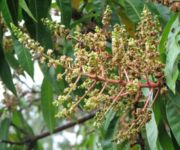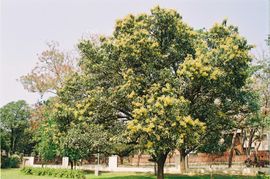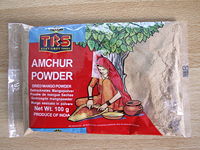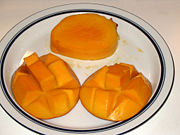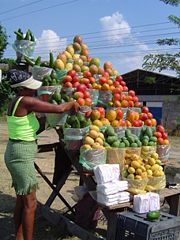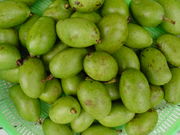Mango
2008/9 Schools Wikipedia Selection. Related subjects: Food; Plants
| Mango | ||||||||||||
|---|---|---|---|---|---|---|---|---|---|---|---|---|
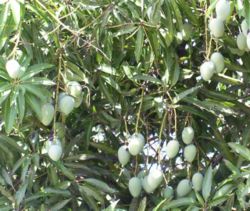 Immature Black Mango fruit
|
||||||||||||
| Scientific classification | ||||||||||||
|
||||||||||||
| Species | ||||||||||||
|
More than 50 species; see listing |
Mangoes belong to the genus Mangifera, consisting of numerous species of tropical fruiting trees in the flowering plant family Anacardiaceae. The mango is indigenous to the Indian subcontinent and Southeast Asia. Cultivated in many tropical regions and distributed widely in the world, mango is one of the most popularly exploited fruits for food, juice, flavor, fragrance and colour. Its leaves are ritually used as floral decorations at weddings and religious ceremonies.
Etymology
The name mango is said to be from the Kodagu mange, the Malayalam manga, or the Tamil mangai, and was loaned into Portuguese in the early 16th century, and from Portuguese passed into English. The ending in -o appears in English and is of unclear origin. Note that in Chinese the word is written both as 杧果 and 芒果 (read mángguǒ in Modern Mandarin, lit. 'pointed fruit'; 芒 máng 'spike/awn of grain/seed').
Description
Mango trees (Mangifera indica) reach 35-40 m in height, with a crown radius of 10 m. The leaves are evergreen, alternate, simple, 15-35 cm long and 6-16 cm broad; when the leaves are young they are orange-pink, rapidly changing to a dark glossy red, then dark green as they mature. The flowers are produced in terminal panicles 10-40 cm long; each flower is small and white with five petals 5-10 mm long, with a mild sweet odour suggestive of lily of the valley. After the flowers finish, the fruit takes from three to six months to ripen.
The ripe fruit is variable in size (right image) and colour, such as yellow, orange, red or purple. Often red on the side facing the sun and yellow where shaded, a mango that is green usually indicates unripe fruit, but this depends on the cultivar. When ripe, the unpeeled fruit gives off a distinctive resinous sweet smell. In its centre is a single flat oblong seed that can be fibrous or hairy on the surface, depending on cultivar. Inside the seed coat 1-2 mm thick is a thin lining covering a single embryo, 4-7 cm long, 3-4 cm wide, 1 cm thick.
Cultivation and uses
Mangoes have been cultivated in the Indian Subcontinent for thousands of years and reached East Asia between the 5th-4th century BC. By the 10th century AD, they were transported to East Africa and subsequently introduced to Brazil, West Indies and Mexico, where climate allows its appropriate growth.
The origins of mango are thought to have been from a plant from Malaysia, India and Indonesia. It probably was grown in southeast Asia before the seventh century, although the only references found are from Cambodia. The 14th century Muslim traveler, Ibn Battuta, reported it at Mogadishu.
Mango is now widely cultivated as a fruit tree in frost-free tropical and warmer subtropical climates throughout the Indian subcontinent, North, South and Central America, the Caribbean, south and central Africa, Australia and Southeast Asia. It is easily cultivated yielding more than 1,000 cultivars, ranging from the "turpentine mango" (named for its strong taste of turpentine, which according to the Oxford Companion to Food some varieties actually contain) to the huevos de toro (literally "eggs of the bull", a euphemism for "bull's testicles", referring to the shape and size).
Although a popular fruit around the world, many mango farmers receive a low price for their produce. This has led to mangoes being available as a fair trade item in some countries. Dwarf or semi-dwarf varieties, such as Nam Doc Mai, yield fruit in containers.
Food
The fruit flesh of a ripe mango is very sweet, with a unique taste. The texture of the flesh varies markedly between different cultivars, some having a soft, pulpy texture similar to an over-ripe plum, while others having firmer flesh like a cantaloupe or avocado. In some cultivars, the flesh has a fibrous texture. Mangoes are juicy with a sweet taste and high water content making them refreshing to eat.
Mangoes are widely used in chutney, which in the West is often very sweet, but in the Indian subcontinent is usually made with sour, unripe mangoes and hot chilis or limes. In India, ripe mango is often cut into thin layers, desiccated, folded, and then cut and sold as bars that are very chewy. These bars, known as amavat or halva in Hindi, are similar to dried guava fruit bars available in Colombia. In many parts of India, people eat squeezed mango juice (called Ras), the thickness of which depends on the type of mango, with variety of bread items and is part of the meal rather than a dessert. Unripe mangoes (which are extremely sour) are eaten with salt, and in regions where food is hotter, with salt and chili.
In Kerala, ripe mango (also ripe jackfruit) is used as a vegetable in the preparation of a dish called mambazha kaalan.
The fruit is also widely used as a key ingredient in a variety of cereal products, in particular muesli and oat granola.
In the Philippines, unripe mango is eaten with bagoong. Dried strips of sweet, ripe mango are also popular, with those from Cebu exported worldwide. Guimaras island is also a major producer of a particularly delicious mango.
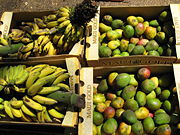
In Mexico, mango is used to make juices, smoothies, ice cream, fruit bars, raspados, aguas frescas, pies and sweet chili sauce, or mixed with chamoy, a sweet and spicy chili paste. It is popular on a stick or also as a main ingredient in fresh fruit combinations.
Pieces of mango can be mashed and used as a topping on ice cream or blended with milk and ice as milkshakes. In Thailand and other South East Asian countries, sweet glutinous rice is flavored with coconut then served with sliced mango on top as a dessert.
In other parts of South-east Asia, mangoes are very popular pickled with fish sauce and rice vinegar.
Dried unripe mango used as a spice and is known as amchur (sometimes spelled amchoor) in India and ambi in Urdu. Amb is a Sindhi and aam is a Hindi/Urdu/ Punjabi word for mango.
The sweet bell pepper ( capsicum) was once known as mango in parts of the midwestern United States.
Nutrient and antioxidant properties
An excellent overall nutritional source, mango is rich in dietary fibre and carbohydrates. It contains diverse essential vitamins and minerals, many of which are particularly high in content. The antioxidant vitamins A, C and E comprise 25%, 76% and 9%, respectively, of the Dietary Reference Intake (DRI) in a 165 g serving. Vitamin B6 (pyridoxine, 11% DRI), vitamin K (9% DRI), other B vitamins and essential nutrients such as potassium, copper and 17 amino acids are at good levels. Mango peel and pulp contain other phytonutrients, such as carotenoids, polyphenols, and omega-3 and -6 polyunsaturated fatty acids.
The edible mango peel has considerable value as a source of dietary fibre and antioxidants. Contained within the peel and pulp are rich contents of polysaccharides as fibre sources, especially starch and pectins.
Antioxidants of the peel and pulp include numerous carotenoids, polyphenols such as quercetin, kaempferol, gallic acid, caffeic acid, catechins, tannins, and the unique mango xanthone, mangiferin, any of which may counteract free radicals in various disease mechanisms as revealed in preliminary research. Up to 25 different carotenoids have been isolated from mango pulp, the densest content for which was beta-carotene accounting for the yellow-orange pigmentation of most mango species. Peel and leaves also have significant content of polyphenols, including xanthones, mangiferin and gallic acid.
The mango triterpene, lupeol is an effective inhibitor in laboratory models of prostate and skin cancers. An extract of mango branch bark called Vimang, isolated by Cuban scientists, contains numerous polyphenols with antioxidant properties in vitro and on blood parameters of elderly humans.
In the same plant family as poison sumac, mango's peel also contains the oil, urushiol, possibly eliciting a skin rash called urushiol-induced contact dermatitis.
| Mango, raw Nutritional value per 100 g (3.5 oz) |
||||||||||||||||||||||||||||||||||||||
|---|---|---|---|---|---|---|---|---|---|---|---|---|---|---|---|---|---|---|---|---|---|---|---|---|---|---|---|---|---|---|---|---|---|---|---|---|---|---|
| Energy 70 kcal 270 kJ | ||||||||||||||||||||||||||||||||||||||
|
||||||||||||||||||||||||||||||||||||||
| Percentages are relative to US recommendations for adults. Source: USDA Nutrient database |
||||||||||||||||||||||||||||||||||||||
Nutrient data in the text are for a 165 g serving as presented by Nutritiondata.com whereas the table presents data for a 100 g serving.
Production and consumption
Approximately 50% of all tropical fruits produced worldwide are mangoes. The Food and Agriculture Organization of the United Nations estimates worldwide production of mangoes at more than 23 million tons in 2001. With 10 million tons, India accounts for almost half of the world production, followed by China (3 million tons), Mexico (1.5 million tons) and Thailand (1.35 million tons). The aggregate production of 10 countries is responsible for roughly 80% of the entire world mango production.
Alphonso, Benishan or Benishaan (Banganpalli in Telugu and Tamil) and Kesar mango varieties are considered among the best mangoes in India. Commonly exported, the Alphonso cultivar is grown exclusively in the Konkan region of Maharashtra. Alphonso is named after Afonso De Albuquerque who reputedly brought the drupe on his journeys to Goa. The locals took to calling this Aphoos in Konkani and in Maharashtra the pronunciation got further corrupted to Hapoos. This variety then was taken to the Konkan region of Maharashtra and other parts of India. Andhra Pradesh and Karnataka states in the south, Gujarat in western India, and Uttar Pradesh and Bihar in the north are major producers of mangoes harvested especially to make spicy mango pickles having regional differences in taste.
Generally, once ripe, mangoes have an orange-yellow or reddish peel and are juicy for eating while those intended for export are often picked while under-ripe with green peels. Although producing ethylene while ripening, unripened exported mangoes do not have the same juiciness or flavor as fresh fruit.
Mangoes are popular throughout Latin America. In Mexico, sliced mango is eaten with chili powder and/or salt. Street vendors sometimes sell whole mangoes on a stick, dipped in the chili-salt mixture. In Indonesia, green mango is sold by street vendors with sugar and salt and/or chili, or used in a sour salad called rujak or rojak in Malaysia and Singapore. Ayurveda considers ripe mango sweet and heating, balancing all three doshas (humors), while also providing energy. Powdered raw mango is sometimes a condiment in various cuisines.
Cultivars
Many hundreds of named mango cultivars exist. In mango orchards, several cultivars are often intermixed to improve cross-pollination.
A common cultivar is Alphonso known in Asia under its original name, Hapoos. Popular outside the Indian subcontinent, Alphonso is an important export product.
Other popular cultivars are mentioned in the list (link above).
Cultivars excelling in one climate may fail to achieve elsewhere. For example, the cultivar Julie, a Jamaican favorite, and Alphonso have not been successfully grown in Florida.
The current world market is dominated by the cultivar Tommy Atkins, a seedling of Haden which first fruited in 1940 in southern Florida, USA. Despite being initially rejected commercially by Florida researchers, Tommy Atkins is now a favorite worldwide. For example, 80% of mangos in UK supermarkets are Tommy Atkins. Despite its fibrous flesh and fair taste, growers world-wide have embraced the cultivar for its exceptional production and disease resistance, the shelf-life of its fruit, their transportability as well as size and appealing colour. Tommy Atkins is predominant in the USA as well, although other cultivars, such Kent, Keitt, the Haitian grown Madame Francis and the Mexican grown Champagne are widely available.
In urban areas of southern Florida, small gardens, or lack thereof, have fueled the desire for dwarf mango trees. The Fairchild Tropical Botanic Garden has promoted "condo mangos" which produce at a height below 2-2.5 m.
A list of additional leading cultivars can be found at the cultivar list in the external links below.
There is an Australian variety of mango known as R2E2, a name based on the orchard row location of the original plant.
